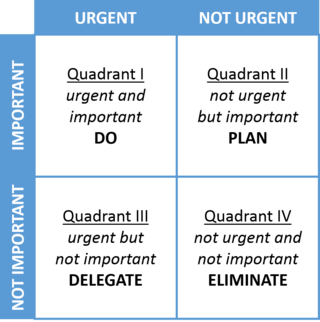A real-time operating system (RTOS) is an operating system (OS) for real-time computing applications that processes data and events that have critically defined time constraints. An RTOS is distinct from a time-sharing operating system, such as Unix, which manages the sharing of system resources with a scheduler, data buffers, or fixed task prioritization in a multitasking or multiprogramming environments. Processing time requirements need to be fully understood and bound rather than just kept as a minimum. All processing must occur within the defined constraints. Real-time operating systems are event-driven and preemptive, meaning the OS can monitor the relevant priority of competing tasks, and make changes to the task priority. Event-driven systems switch between tasks based on their priorities, while time-sharing systems switch the task based on clock interrupts.
Time management is the process of planning and exercising conscious control of time spent on specific activities—especially to increase effectiveness, efficiency, and productivity.

Financial statements are formal records of the financial activities and position of a business, person, or other entity.
In computing, scheduling is the action of assigning resources to perform tasks. The resources may be processors, network links or expansion cards. The tasks may be threads, processes or data flows.
Questionnaire construction refers to the design of a questionnaire to gather statistically useful information about a given topic. When properly constructed and responsibly administered, questionnaires can provide valuable data about any given subject.

Getting Things Done (GTD) is a personal productivity system developed by David Allen and published in a book of the same name. GTD is described as a time management system. Allen states "there is an inverse relationship between things on your mind and those things getting done".

A checklist is a type of job aid used in repetitive tasks to reduce failure by compensating for potential limits of human memory and attention. Checklists are used both to ensure that safety-critical system preparations are carried out completely and in the correct order, and in less critical applications to ensure that no step is left out of a procedure. they help to ensure consistency and completeness in carrying out a task. A basic example is the "to do list". A more advanced checklist would be a schedule, which lays out tasks to be done according to time of day or other factors, or a pre-flight checklist for an airliner, which should ensure a safe take-off.
The MoSCoW method is a prioritization technique used in management, business analysis, project management, and software development to reach a common understanding with stakeholders on the importance they place on the delivery of each requirement; it is also known as MoSCoW prioritization or MoSCoW analysis.

First Things First (1994) is a self-help book written by Stephen Covey, A. Roger Merrill, and Rebecca R. Merrill. It offers a time management approach that, if established as a habit, is intended to help readers achieve "effectiveness" by aligning themselves to "First Things". The approach is a further development of the approach popularized in Covey's The Seven Habits of Highly Effective People and other titles.

Task management is the process of overseeing a task through its lifecycle. It involves planning, testing, tracking, and reporting. Task management can help individuals achieve goals or enable groups of individuals to collaborate and share knowledge for the accomplishment of collective goals. Tasks are also differentiated by complexity, from low to high.
Software project management is the process of planning and leading software projects. It is a sub-discipline of project management in which software projects are planned, implemented, monitored and controlled.

Alan Lakein was an American author on personal time management, including How to Get Control of Your Time and Your Life which has sold over 3 million copies.

Scrum is an agile team collaboration framework commonly used in software development and other industries.
Sentiment analysis is the use of natural language processing, text analysis, computational linguistics, and biometrics to systematically identify, extract, quantify, and study affective states and subjective information. Sentiment analysis is widely applied to voice of the customer materials such as reviews and survey responses, online and social media, and healthcare materials for applications that range from marketing to customer service to clinical medicine. With the rise of deep language models, such as RoBERTa, also more difficult data domains can be analyzed, e.g., news texts where authors typically express their opinion/sentiment less explicitly.
Free recall is a common task in the psychological study of memory. In this task, participants study a list of items on each trial, and then are prompted to recall the items in any order. Items are usually presented one at a time for a short duration, and can be any of a number of nameable materials, although traditionally, words from a larger set are chosen. The recall period typically lasts a few minutes, and can involve spoken or written recall. The standard test involves the recall period starting immediately after the final list item; this can be referred to as immediate free recall (IFR) to distinguish it from delayed free recall (DFR). In delayed free recall, there is a short distraction period between the final list item and the start of the recall period. Both IFR and DFR have been used to test certain effects that appear during recall tests, such as the primacy effect and recency effect.
Knowledge organization (KO), organization of knowledge, organization of information, or information organization is an intellectual discipline concerned with activities such as document description, indexing, and classification that serve to provide systems of representation and order for knowledge and information objects. According to The Organization of Information by Joudrey and Taylor, information organization:
examines the activities carried out and tools used by people who work in places that accumulate information resources for the use of humankind, both immediately and for posterity. It discusses the processes that are in place to make resources findable, whether someone is searching for a single known item or is browsing through hundreds of resources just hoping to discover something useful. Information organization supports a myriad of information-seeking scenarios.
Field inventory management, commonly known as inventory management, is the task of understanding the stock mix of a company and the handling of the different demands placed on that stock. The demands are influenced by both external and internal factors and are balanced by the creation of purchase order requests to keep supplies at a reasonable or prescribed level. Inventory management is important for every other business enterprise.
Mark Forster is a British author best known for three books on time management and productivity. A business coach until he retired on 24 November 2008, in the past he has also worked for the British Army, Ministry of Defence and the Church of England.
Intelligence collection management is the process of managing and organizing the collection of intelligence from various sources. The collection department of an intelligence organization may attempt basic validation of what it collects, but is not supposed to analyze its significance. There is debate in U.S. intelligence community on the difference between validation and analysis, where the National Security Agency may try to interpret information when such interpretation is the job of another agency.
Scrumban is an Agile aligned approach to product delivery which is a hybrid of Scrum and Kanban. Scrumban was originally designed as a way to transition from Scrum to Kanban.









